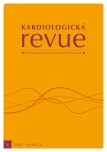Thrombolytic therapy of cerebral infarction
Authors:
D. Goldemund; R. Mikulík; M. Reif
Published in:
Kardiol Rev Int Med 2008, 10(4): 168-176
Overview
The purpose of thrombolytic therapy is to recanalize the cerebral vessel occluded by a thrombus or an embolus. According to applicable guidelines, the standard therapy of acute cerebral infarcti on consists in intraveno us thrombolysis within three ho urs from the occurrence of the vascular event. Current rese arch is focused on the selecti on of candidates who are still suitable for thrombolysis after the expirati on of the three- ho ur peri od, and on incre asing the percentage of recanalizati ons (enhanced thrombolysis, interventi on techniques). The a uthors present new results of the ECASS III study which justify the extensi on of the therape utic window to 4.5 ho urs from the occurrence of symptoms.
Key words:
acute cerebral infarction – systemic thrombolysis – combined thrombolysis – ECASS III
Sources
1. Wilson JT, Hareendran A, Hendry A et al. Reli ability of the modifi ed Rankin Scale across multiple raters: benefits of a structured intervi ew. Stroke 2005; 36: 777– 781.
2. Smith WS, Sung G, Starkman S et al. Safety and efficacy of mechanical embolectomy in acute ischemic stroke: results of the MERCI tri al. Stroke 2005; 36: 1432– 1438.
3. Hacke W, Donnan G, Fi eschi C et al. Associ ati on of o utcome with e arly stroke tre atment: po oled analysis of ATLANTIS, ECASS, and NINDS rt- PA stroke tri als. Lancet 2004; 363: 768– 774.
4. Adams HP Jr, del Zoppo G, Alberts MJ et al. Guidelines for the e arly management of adults with ischemic stroke: a guideline from the American He art Associ ati on/ American Stroke Associ ati on Stroke Co uncil, Clinical Cardi ology Co uncil, Cardi ovascular Radi ology and Interventi on Co uncil, and the Atherosclerotic Peripheral Vascular Dise ase and Qu ality of Care Outcomes in Rese arch Interdisciplinary Working Gro ups: the American Academy of Ne urology affirms the value of this guideline as an educati onal to ol for ne urologists. Stroke 2007; 38: 1655– 1711.
5. Tissue plasminogen activator for acute ischemic stroke. The Nati onal Institute of Ne urological Disorders and Stroke rt- PA Stroke Study Gro up. N Engl J Med 1995; 333: 1581– 1587.
6. Goldstein LB, Samsa GP. Reli ability of the Nati onal Institutes of He alth Stroke Scale. Extensi on to non‑ne urologists in the context of a clinical tri al. Stroke 1997; 28: 307– 310.
7. Wahlgren N, Ahmed N, Dávalos A et al. Thrombolysis with alteplase for acute ischaemic stroke in the Safe Implementati on of Thrombolysis in Stroke- Monitoring Study (SITS- MOST): an observati onal study. Lancet 2007; 369: 275– 282.
8. Hacke W, Kaste M, Fi eschi C et al. Randomised do uble- blind placebo- controlled tri al of thrombolytic therapy with intraveno us alteplase in acute ischaemic stroke (ECASS II). Second Europe an- Australasi an Acute Stroke Study Investigators. Lancet 1998; 352: 1245– 1251.
9. Hacke W, Brott T, Caplan L et al. Thrombolysis in acute ischemic stroke: controlled tri als and clinical experi ence. Ne urology 1999; 53: S3– S14.
10. Hacke W, Kaste M, Bluhmki E et al. Thrombolysis with alteplase 3 to 4.5 ho urs after acute ischemic stroke. N Engl J Med 2008; 359: 1317– 1329.
11. Hacke W, Albers G, Al- Rawi Y et al. The Desmoteplase in Acute Ischemic Stroke Tri al (DIAS): a phase II MRI‑based 9- ho ur window acute stroke thrombolysis tri al with intraveno us desmoteplase. Stroke 2005; 36: 66– 73.
12. Furlan AJ, Eyding D, Albers GW et al. Dose Escalati on of Desmoteplase for Acute Ischemic Stroke (DEDAS): evidence of safety and efficacy 3 to 9 ho urs after stroke onset. Stroke 2006; 37: 1227– 1231.
13. Furlan A, Higashida R, Wechsler L et al. Intra- arteri al pro urokinase for acute ischemic stroke. The PROACT II study: a randomized controlled tri al. Prolyse in Acute Cerebral Thromboembolism. Jama 1999; 282: 2003– 2011.
14. IMS Study Investigators. Combined intraveno us and intra- arteri al recanalizati on for acute ischemic stroke: the Interventi onal Management of Stroke Study. Stroke 2004; 35: 904– 911.
15. Braaten JV, Goss RA, Francis CW. Ultraso und reversibly disaggregates fibrin fibers. Thromb Haemost 1997; 78: 1063– 1068.
16. Alexandrov AV, Wojner AW, Grotta JC. CLOTBUST: design of a randomized tri al of ultraso und- enhanced thrombolysis for acute ischemic stroke. J Ne uro imaging 2004; 14: 108– 112.
17. Daffertshofer M, Gass A, Ringleb P et al. Transcrani al low- frequency ultraso und- medi ated thrombolysis in brain ischemi a: incre ased risk of hemorrhage with combined ultraso und and tissue plasminogen activator: results of a phase II clinical tri al. Stroke 2005; 36: 1441– 1446.
18. Smith WS. Safety of mechanical thrombectomy and intraveno us tissue plasminogen activator in acute ischemic stroke. Results of the multi Mechanical Embolus Removal in Cerebral Ischemi a (MERCI) tri al, part I. AJNR Am J Ne uroradi ol 2006; 27: 1177– 1182.
19. Mikulík R, Bunt L, Hrdlicka D et al. Calling 911 in response to stroke: a nati onwide study assessing definitive individu al behavi or. Stroke 2008; 39: 1844– 1849.
Labels
Paediatric cardiology Internal medicine Cardiac surgery CardiologyArticle was published in
Cardiology Review

2008 Issue 4
Most read in this issue
- Hypertensive disease and heart rate
- Abdominal obesity – an epidemic of the 21st century
- Thrombolytic therapy of cerebral infarction
- Central and peripheral blo od pressure and their control by tre atment
